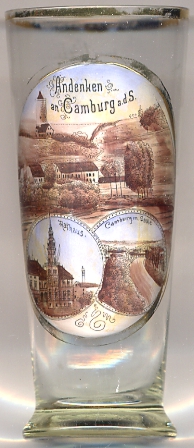

|
| DEUTSCHLAND | GERMANY |
| Bundesland: Freistaat Thüringen | Thuringia |
| Landkreis: Saale-Holzland-Kreis |
 Camburg is situated at an elevation of 127 m on the river Saale in the northeast of Germany's state of Thuringia, about midway between
Jena and Naumburg (Saale). Camburg has a population of about 2,850 (2007) and is part of the
municipality Dornburg-Camburg.
Camburg is situated at an elevation of 127 m on the river Saale in the northeast of Germany's state of Thuringia, about midway between
Jena and Naumburg (Saale). Camburg has a population of about 2,850 (2007) and is part of the
municipality Dornburg-Camburg.
The earliest written document mentioning Camburg is dated to 1078. One of the famous 12 statues of peers ('Stifterfiguren') from the Naumburg
cathedral depicts a Wilhelm of Camburg (†1166). Part of the settlement was mentioned as an 'civitas' in 1420. The domains of Dornburg and Camburg
were administered as one body until the 17th century. Until about the time of the Reformation (introduced here in 1539), the area belongedto many different owners;
only after that date the domais were consolidated into one single domain of the Wettin dynasty. From 1485 it beonged to the Albertine line of the dynasty, from
1547 to the Ernestine line. During he following centuries it belonged to various Ernestine lines: 1603 Saxe-Altenburg, 1672 Saxe-Gotha,
1680 Saxe-Eisenberg, 1707 Saxe-Gotha-Altenburg, and 1826 Saxe-Meiningen. Since 1918 it was part of the district (Kreisabteilung)
Camburg, which later was incorporated into the district (Landkreis) Stadtroda. Between 1952 and 1994 it was part of the district (Kreis)
Jena-Land (Jena country), and today is part of the district Saale-Holzland-Kreis.
[https://de.wikipedia.org/wiki/Camburg]
 Camburg castle [top picture: background left] is situated on a steep
spur above the town. The earliest written mentions document owners of the Wettin dynasty already in the second half of the 11th century. After frequent changes
in owners during the 14th and 15th century, the castle was finally destroyed by Elector Friedrich II 'der Sanftmütige ('the Gentle') during the Saxon
Fratricidal War (Sächsischer Bruderkrieg; 1446–1451) between Friedrich and his younger brother Duke Wilhelm III ('der Tapfere', 'the Brave').
Only the tall castle keep (37 metres high) remains today.
Camburg castle [top picture: background left] is situated on a steep
spur above the town. The earliest written mentions document owners of the Wettin dynasty already in the second half of the 11th century. After frequent changes
in owners during the 14th and 15th century, the castle was finally destroyed by Elector Friedrich II 'der Sanftmütige ('the Gentle') during the Saxon
Fratricidal War (Sächsischer Bruderkrieg; 1446–1451) between Friedrich and his younger brother Duke Wilhelm III ('der Tapfere', 'the Brave').
Only the tall castle keep (37 metres high) remains today.
[https://de.wikipedia.org/wiki/Camburg]
The  Town hall [bottom left picture]
was built in Renaissance revival style in 1889.
Town hall [bottom left picture]
was built in Renaissance revival style in 1889.
![[scale]](lineal.jpg)